Investigating Adsorption-Based Atmospheric Water Harvesting Potential for Pakistan
Abstract
1. Introduction
2. Bibliometric Background of Adsorption-Based AWH
3. Materials and Methods
3.1. Adsorption-Based AWH System
3.2. Adsorption Modeling
3.3. Simulation Analysis
4. Results and Discussion
4.1. Geospatial Mapping
4.2. Simulation Results
5. Conclusions
Author Contributions
Funding
Institutional Review Board Statement
Informed Consent Statement
Data Availability Statement
Acknowledgments
Conflicts of Interest
References
- Yu, Q.; Wang, Y.; Li, N. Extreme Flood Disasters: Comprehensive Impact and Assessment. Water 2022, 14, 1211. [Google Scholar] [CrossRef]
- Zhang, K.; Shalehy, M.H.; Ezaz, G.T.; Chakraborty, A.; Mohib, K.M.; Liu, L. An Integrated Flood Risk Assessment Approach Based on Coupled Hydrological-Hydraulic Modeling and Bottom-up Hazard Vulnerability Analysis. Environ. Model. Softw. 2022, 148, 105279. [Google Scholar] [CrossRef]
- Liu, Y.; Zhang, K.; Li, Z.; Liu, Z.; Wang, J.; Huang, P. A Hybrid Runoff Generation Modelling Framework Based on Spatial Combination of Three Runoff Generation Schemes for Semi-Humid and Semi-Arid Watersheds. J. Hydrol. 2020, 590, 125440. [Google Scholar] [CrossRef]
- Quan, Q.; Gao, S.; Shang, Y.; Wang, B. Assessment of the Sustainability of Gymnocypris Eckloni Habitat under River Damming in the Source Region of the Yellow River. Sci. Total Environ. 2021, 778, 146312. [Google Scholar] [CrossRef]
- Quan, Q.; Liang, W.; Yan, D.; Lei, J. Influences of Joint Action of Natural and Social Factors on Atmospheric Process of Hydrological Cycle in Inner Mongolia, China. Urban Clim. 2022, 41, 101043. [Google Scholar] [CrossRef]
- Chen, X.; Quan, Q.; Zhang, K.; Wei, J. Spatiotemporal Characteristics and Attribution of Dry/Wet Conditions in the Weihe River Basin within a Typical Monsoon Transition Zone of East Asia over the Recent 547 Years. Environ. Model. Softw. 2021, 143, 105116. [Google Scholar] [CrossRef]
- Zhang, K.; Ali, A.; Antonarakis, A.; Moghaddam, M.; Saatchi, S.; Tabatabaeenejad, A.; Chen, R.; Jaruwatanadilok, S.; Cuenca, R.; Crow, W.T.; et al. The Sensitivity of North American Terrestrial Carbon Fluxes to Spatial and Temporal Variation in Soil Moisture: An Analysis Using Radar-Derived Estimates of Root-Zone Soil Moisture. J. Geophys. Res. Biogeosciences 2019, 124, 3208–3231. [Google Scholar] [CrossRef]
- Zhang, K.; Wang, S.; Bao, H.; Zhao, X. Characteristics and Influencing Factors of Rainfall-Induced Landslide and Debris Flow Hazards in Shaanxi Province, China. Nat. Hazards Earth Syst. Sci. 2019, 19, 93–105. [Google Scholar] [CrossRef]
- Wang, S.; Zhang, K.; Chao, L.; Li, D.; Tian, X.; Bao, H.; Chen, G.; Xia, Y. Exploring the Utility of Radar and Satellite-Sensed Precipitation and Their Dynamic Bias Correction for Integrated Prediction of Flood and Landslide Hazards. J. Hydrol. 2021, 603, 126964. [Google Scholar] [CrossRef]
- Xie, W.; Li, X.; Jian, W.; Yang, Y.; Liu, H.; Robledo, L.F.; Nie, W. A Novel Hybrid Method for Landslide Susceptibility Mapping-Based GeoDetector and Machine Learning Cluster: A Case of Xiaojin County, China. ISPRS Int. J. Geo-Information 2021, 10, 93. [Google Scholar] [CrossRef]
- Xie, W.; Nie, W.; Saffari, P.; Robledo, L.F.; Descote, P.-Y.; Jian, W. Landslide Hazard Assessment Based on Bayesian Optimization–Support Vector Machine in Nanping City, China. Nat. Hazards 2021, 109, 931–948. [Google Scholar] [CrossRef]
- Ligtvoet, W.; Hilderink, H. Towards a World of Cities in 2050 An Outlook on Water- Related Challenges—Background Report to the UN-Habitat Global Report; PBL Netherlands Environmental Assessment Agency: Hague, The Netherlands, 2014; ISBN 9789491506758. [Google Scholar]
- Assembly, U.G. Global Indicator Framework for the Sustainable Development Goals and Targets of the 2030 Agenda for Sustainable Development; United Nations Statistics Division: New York, NY, USA, 2017. [Google Scholar]
- Mekonnen, M.M.; Hoekstra, A.Y. Four Billion People Facing Severe Water Scarcity. Sci. Adv. 2016, 2, e1500323. [Google Scholar] [CrossRef]
- Liu, S.; Liu, Y.; Wang, C.; Dang, X. The Distribution Characteristics and Human Health Risks of High- Fluorine Groundwater in Coastal Plain: A Case Study in Southern Laizhou Bay, China. Front. Environ. Sci. 2022, 10, 568. [Google Scholar] [CrossRef]
- Hu, S.; Wu, H.; Liang, X.; Xiao, C.; Zhao, Q.; Cao, Y.; Han, X. A Preliminary Study on the Eco-Environmental Geological Issue of in-Situ Oil Shale Mining by a Physical Model. Chemosphere 2022, 287, 131987. [Google Scholar] [CrossRef]
- Li, X.; Wang, Y.; Hu, Y.; Zhou, C.; Zhang, H. Numerical Investigation on Stratum and Surface Deformation in Underground Phosphorite Mining Under Different Mining Methods. Front. Earth Sci. 2022, 10. [Google Scholar] [CrossRef]
- Durrani, Z.K. Water Scarcity and Social Vulnerabilities: A Multi-Dimensional Perspective of Water Challenges in Pakistan. J. Sustain. Educ. 2020. Available online: http://www.susted.com/wordpress/content/water-scarcity-and-social-vulnerabilities-a-multi-dimensional-perspective-of-water-challenges-in-pakistan_2020_03/ (accessed on 22 September 2022).
- Nabi, G.; Ali, M.; Khan, S.; Kumar, S. The Crisis of Water Shortage and Pollution in Pakistan: Risk to Public Health, Biodiversity, and Ecosystem. Environ. Sci. Pollut. Res. 2019, 26, 10443–10445. [Google Scholar] [CrossRef]
- Mikosch, N.; Becker, R.; Schelter, L.; Berger, M.; Usman, M.; Finkbeiner, M. High Resolution Water Scarcity Analysis for Cotton Cultivation Areas in Punjab, Pakistan. Ecol. Indic. 2020, 109, 105852. [Google Scholar] [CrossRef]
- Sullivan, C.A.; Meigh, J.R.; Giacomello, A.M. The Water Poverty Index: Development and Application at the Community Scale. Nat. Resour. Forum 2003, 27, 189–199. [Google Scholar] [CrossRef]
- Daud, M.K.; Nafees, M.; Ali, S.; Rizwan, M.; Bajwa, R.A.; Shakoor, M.B.; Arshad, M.U.; Chatha, S.A.S.; Deeba, F.; Murad, W.; et al. Drinking Water Quality Status and Contamination in Pakistan. Biomed Res. Int. 2017, 2017, 7908183. [Google Scholar] [CrossRef]
- Aslam, M.M.A.; Kuo, H.-W.; Den, W.; Sultan, M.; Rasool, K.; Bilal, M. Chapter 10—Recent Trends of Carbon Nanotubes and Chitosan Composites for Hexavalent Chromium Removal from Aqueous Samples. In Separations of Water Pollutants with Nanotechnology; Ahuja, S., Ed.; Academic Press: Cambridge, MA, USA, 2022; Volume 15, pp. 177–207. ISBN 1877-1718. [Google Scholar]
- Liu, W.; Huang, F.; Wang, Y.; Zou, T.; Zheng, J.; Lin, Z. Recycling Mg(OH) 2 Nanoadsorbent during Treating the Low Concentration of Cr VI. Environ. Sci. Technol. 2011, 45, 1955–1961. [Google Scholar] [CrossRef] [PubMed]
- Rasheed, H.; Altaf, F.; Anwaar, K.; Ashraf, M. Drinking Water Quality in Pakistan: Current Status and Challenges; PCRWR: Islamabad, Pakistan, 2021. [Google Scholar]
- Riaz, N.; Sultan, M.; Miyazaki, T.; Shahzad, M.W.; Farooq, M.; Sajjad, U.; Niaz, Y. A Review of Recent Advances in Adsorption Desalination Technologies. Int. Commun. Heat Mass Transf. 2021, 128, 105594. [Google Scholar] [CrossRef]
- Mohammed, R.H.; Rezk, A.; Askalany, A.; Ali, E.S.; Zohir, A.E.; Sultan, M.; Ghazy, M.; Abdelkareem, M.A.; Olabi, A.G. Metal-Organic Frameworks in Cooling and Water Desalination: Synthesis and Application. Renew. Sustain. Energy Rev. 2021, 149, 111362. [Google Scholar] [CrossRef]
- Hutton, G.; Varughese, M. The Costs of Meeting the 2030 Sustainable Development Goal Targets on Drinking Water, Sanitation, and Hygiene. World Bank, Washington, DC. © World Bank. Tech. Pap. 2016. Available online: https://openknowledge.worldbank.org/handle/10986/16996 (accessed on 22 September 2022).
- Humphrey, J.H.; Brown, J.; Cumming, O.; Evans, B.; Howard, G.; Kulabako, R.N.; Lamontagne, J.; Pickering, A.J.; Wang, E.N. The Potential for Atmospheric Water Harvesting to Accelerate Household Access to Safe Water. Lancet Planet. Heal. 2020, 4, e91–e92. [Google Scholar] [CrossRef]
- Zhang, Z.; Tian, J.; Huang, W.; Yin, L.; Zheng, W.; Liu, S. A Haze Prediction Method Based on One-Dimensional Convolutional Neural Network. Atmosphere 2021, 12, 1327. [Google Scholar] [CrossRef]
- Yin, L.; Wang, L.; Huang, W.; Liu, S.; Yang, B.; Zheng, W. Spatiotemporal Analysis of Haze in Beijing Based on the Multi-Convolution Model. Atmosphere 2021, 12, 1408. [Google Scholar] [CrossRef]
- Wu, X.; Liu, Z.; Yin, L.; Zheng, W.; Song, L.; Tian, J.; Yang, B.; Liu, S. A Haze Prediction Model in Chengdu Based on LSTM. Atmosphere 2021, 12, 1479. [Google Scholar] [CrossRef]
- Shang, K.; Chen, Z.; Liu, Z.; Song, L.; Zheng, W.; Yang, B.; Liu, S.; Yin, L. Haze Prediction Model Using Deep Recurrent Neural Network. Atmosphere 2021, 12, 1625. [Google Scholar] [CrossRef]
- Bilal, M.; Sultan, M.; Morosuk, T.; Den, W.; Sajjad, U.; Aslam, M.M.A.; Shahzad, M.W.; Farooq, M. Adsorption-Based Atmospheric Water Harvesting: A Review of Adsorbents and Systems. Int. Commun. Heat Mass Transf. 2022, 133, 105961. [Google Scholar] [CrossRef]
- Wasti, T.Z.; Sultan, M.; Aleem, M.; Sajjad, U.; Farooq, M.; Raza, H.M.U.; Khan, M.U.; Noor, S. An Overview of Solid and Liquid Materials for Adsorption-Based Atmospheric Water Harvesting. Adv. Mech. Eng. 2022, 14, 16878132221082768. [Google Scholar] [CrossRef]
- Hanikel, N.; Prévot, M.S.; Yaghi, O.M. MOF Water Harvesters. Nat. Nanotechnol. 2020, 15, 348–355. [Google Scholar] [CrossRef]
- Kalmutzki, M.J.; Diercks, C.S.; Yaghi, O.M. Metal–Organic Frameworks for Water Harvesting from Air. Adv. Mater. 2018, 30, 1–26. [Google Scholar] [CrossRef]
- Kallenberger, P.A.; Fröba, M. Water Harvesting from Air with a Hygroscopic Salt in a Hydrogel–Derived Matrix. Commun. Chem. 2018, 1, 6–11. [Google Scholar] [CrossRef]
- Xi, M.; He, C.; Yang, H.; Fu, X.; Fu, L.; Cheng, X.; Guo, J. Predicted a Honeycomb Metallic BiC and a Direct Semiconducting Bi2C Monolayer as Excellent CO2 Adsorbents. Chinese Chem. Lett. 2022, 33, 2595–2599. [Google Scholar] [CrossRef]
- Boriskina, S.V.; Raza, A.; Zhang, T.; Wang, P.; Zhou, L.; Zhu, J. Nanomaterials for the Water-Energy Nexus. MRS Bull. 2019, 44, 59–66. [Google Scholar] [CrossRef]
- Furukawa, H.; Gándara, F.; Zhang, Y.B.; Jiang, J.; Queen, W.L.; Hudson, M.R.; Yaghi, O.M. Water Adsorption in Porous Metal-Organic Frameworks and Related Materials. J. Am. Chem. Soc. 2014, 136, 4369–4381. [Google Scholar] [CrossRef]
- Chua, H.T.; Ng, K.C.; Chakraborty, A.; Oo, N.M.; Othman, M.A. Adsorption Characteristics of Silica Gel + Water Systems. J. Chem. Eng. Data 2002, 47, 1177–1181. [Google Scholar] [CrossRef]
- Wang, Y.; LeVan, M.D. Adsorption Equilibrium of Carbon Dioxide and Water Vapor on Zeolites 5A and 13X and Silica Gel: Pure Components. J. Chem. Eng. Data 2009, 54, 2839–2844. [Google Scholar] [CrossRef]
- Sultan, M.; Miyazaki, T.; Koyama, S.; Khan, Z.M. Performance Evaluation of Hydrophilic Organic Polymer Sorbents for Desiccant Air-Conditioning Applications. Adsorpt. Sci. Technol. 2018, 36, 311–326. [Google Scholar] [CrossRef]
- Ashraf, S.; Sultan, M.; Bahrami, M.; McCague, C.; Shahzad, M.W.; Amani, M.; Shamshiri, R.R.; Ali, H.M. Recent Progress on Water Vapor Adsorption Equilibrium by Metal-Organic Frameworks for Heat Transformation Applications. Int. Commun. Heat Mass Transf. 2021, 124, 105242. [Google Scholar] [CrossRef]
- Bai, B.; Rao, D.; Chang, T.; Guo, Z. A Nonlinear Attachment-Detachment Model with Adsorption Hysteresis for Suspension-Colloidal Transport in Porous Media. J. Hydrol. 2019, 578, 124080. [Google Scholar] [CrossRef]
- Fundamentals, A. Handbook; American Society of Heating, Refrigerating and Air-Conditioning Engineers: Peachtree Corners, GA, USA, 2013; pp. 20–26. [Google Scholar]
- Kim, S.-I.; Yoon, T.-U.; Kim, M.-B.; Lee, S.-J.; Hwang, Y.K.; Chang, J.-S.; Kim, H.-J.; Lee, H.-N.; Lee, U.-H.; Bae, Y.-S. Metal–Organic Frameworks with High Working Capacities and Cyclic Hydrothermal Stabilities for Fresh Water Production. Chem. Eng. J. 2016, 286, 467–475. [Google Scholar] [CrossRef]
- Henninger, S.K.; Munz, G.; Ratzsch, K.-F.; Schossig, P. Cycle Stability of Sorption Materials and Composites for the Use in Heat Pumps and Cooling Machines. Renew. Energy 2011, 36, 3043–3049. [Google Scholar] [CrossRef]
- Donthu, N.; Kumar, S.; Mukherjee, D.; Pandey, N.; Lim, W.M. How to Conduct a Bibliometric Analysis: An Overview and Guidelines. J. Bus. Res. 2021, 133, 285–296. [Google Scholar] [CrossRef]
- Siddiqui, M.A.; Azam, M.A.; Khan, M.M.; Iqbal, S.; Khan, M.U.; Raffat, Y. Current Trends on Extraction of Water from Air: An Alternative Solution to Water Supply. Int. J. Environ. Sci. Technol. 2022, 1–28. [Google Scholar] [CrossRef]
- Kim, H.; Yang, S.; Rao, S.R.; Narayanan, S.; Kapustin, E.A.; Furukawa, H.; Umans, A.S.; Yaghi, O.M.; Wang, E.N. Water Harvesting from Air with Metal-Organic Frameworks Powered by Natural Sunlight. Science 2017, 356, 430. [Google Scholar] [CrossRef]
- Kim, H.; Rao, S.R.; Kapustin, E.A.; Zhao, L.; Yang, S.; Yaghi, O.M.; Wang, E.N. Adsorption-Based Atmospheric Water Harvesting Device for Arid Climates. Nat. Commun. 2018, 9, 1191. [Google Scholar] [CrossRef]
- Tu, Y.; Wang, R.; Zhang, Y.; Wang, J. Progress and Expectation of Atmospheric Water Harvesting. Joule 2018, 2, 1452–1475. [Google Scholar] [CrossRef]
- Zhao, F.; Zhou, X.; Liu, Y.; Shi, Y.; Dai, Y.; Yu, G. Super Moisture-Absorbent Gels for All-Weather Atmospheric Water Harvesting. Adv. Mater. 2019, 31, 1806446. [Google Scholar] [CrossRef]
- Hanikel, N.; Prévot, M.S.; Fathieh, F.; Kapustin, E.A.; Lyu, H.; Wang, H.; Diercks, N.J.; Glover, T.G.; Yaghi, O.M. Rapid Cycling and Exceptional Yield in a Metal-Organic Framework Water Harvester. ACS Cent. Sci. 2019, 5, 1699–1706. [Google Scholar] [CrossRef] [PubMed]
- Seo, D.; Lee, J.; Lee, C.; Nam, Y. The Effects of Surface Wettability on the Fog and Dew Moisture Harvesting Performance on Tubular Surfaces. Sci. Rep. 2016, 6, 24276. [Google Scholar] [CrossRef]
- Stegbauer, L.; Hahn, M.W.; Jentys, A.; Savasci, G.; Ochsenfeld, C.; Lercher, J.A.; Lotsch, B. V Tunable Water and CO2 Sorption Properties in Isostructural Azine-Based Covalent Organic Frameworks through Polarity Engineering. Chem. Mater. 2015, 27, 7874–7881. [Google Scholar] [CrossRef]
- Li, R.; Shi, Y.; Alsaedi, M.; Wu, M.; Shi, L.; Wang, P. Hybrid Hydrogel with High Water Vapor Harvesting Capacity for Deployable Solar-Driven Atmospheric Water Generator. Environ. Sci. Technol. 2018, 52, 11367–11377. [Google Scholar] [CrossRef] [PubMed]
- Zhang, C.; Liang, H.; Xu, Z.; Wang, Z. Harnessing Solar-Driven Photothermal Effect toward the Water–Energy Nexus. Adv. Sci. 2019, 6, 1900883. [Google Scholar] [CrossRef] [PubMed]
- Nandakumar, D.K.; Zhang, Y.; Ravi, S.K.; Guo, N.; Zhang, C.; Tan, S.C. Solar Energy Triggered Clean Water Harvesting from Humid Air Existing above Sea Surface Enabled by a Hydrogel with Ultrahigh Hygroscopicity. Adv. Mater. 2019, 31, 1806730. [Google Scholar] [CrossRef] [PubMed]
- Zhou, X.; Lu, H.; Zhao, F.; Yu, G. Atmospheric Water Harvesting: A Review of Material and Structural Designs. ACS Mater. Lett. 2020, 2, 671–684. [Google Scholar] [CrossRef]
- LaPotin, A.; Kim, H.; Rao, S.R.; Wang, E.N. Adsorption-Based Atmospheric Water Harvesting: Impact of Material and Component Properties on System-Level Performance. Acc. Chem. Res. 2019, 52, 1588–1597. [Google Scholar] [CrossRef]
- Li, R.; Shi, Y.; Shi, L.; Alsaedi, M.; Wang, P. Harvesting Water from Air: Using Anhydrous Salt with Sunlight. Environ. Sci. Technol. 2018, 52, 5398–5406. [Google Scholar] [CrossRef]
- Vivekh, P.; Kumja, M.; Bui, D.T.; Chua, K.J. Recent Developments in Solid Desiccant Coated Heat Exchangers – A Review. Appl. Energy 2018, 229, 778–803. [Google Scholar] [CrossRef]
- Kabeel, A.E. Water Production from Air Using Multi-Shelves Solar Glass Pyramid System. Renew. Energy 2007, 32, 157–172. [Google Scholar] [CrossRef]
- Xu, J.; Li, T.; Chao, J.; Wu, S.; Yan, T.; Li, W.; Cao, B.; Wang, R. Efficient Solar-Driven Water Harvesting from Arid Air with Metal–Organic Frameworks Modified by Hygroscopic Salt. Angew. Chemie Int. Ed. 2020, 59, 5202–5210. [Google Scholar] [CrossRef]
- Li, R.; Shi, Y.; Wu, M.; Hong, S.; Wang, P. Improving Atmospheric Water Production Yield: Enabling Multiple Water Harvesting Cycles with Nano Sorbent. Nano Energy 2020, 67, 104255. [Google Scholar] [CrossRef]
- Nguyen, H.L.; Hanikel, N.; Lyle, S.J.; Zhu, C.; Proserpio, D.M.; Yaghi, O.M. A Porous Covalent Organic Framework with Voided Square Grid Topology for Atmospheric Water Harvesting. J. Am. Chem. Soc. 2020, 142, 2218–2221. [Google Scholar] [CrossRef]
- Sultan, M.; Bilal, M.; Miyazaki, T.; Sajjad, U.; Ahmad, F. Adsorption-Based Atmospheric Water Harvesting: Technology Fundamentals and Energy-Efficient Adsorbents. In Technologies in Agriculture; Ahmad, F., Sultan, M., Eds.; IntechOpen: London, UK, 2021. [Google Scholar]
- Sultan, M.; El-Sharkawy, I.I.; Miyazaki, T.; Saha, B.B.; Koyama, S.; Maruyama, T.; Maeda, S.; Nakamura, T. Insights of Water Vapor Sorption onto Polymer Based Sorbents. Adsorption 2015, 21, 205–215. [Google Scholar] [CrossRef]
- Seo, Y.; Yoon, J.W.; Lee, J.S.; Hwang, Y.K.; Jun, C.; Chang, J.; Wuttke, S.; Bazin, P.; Vimont, A.; Daturi, M.; et al. Energy-Efficient Dehumidification over Hierachically Porous Metal-Organic Frameworks as Advanced Water Adsorbents. Adv. Mater. 2012, 24, 806–810. [Google Scholar] [CrossRef]
- Yan, J.; Yu, Y.; Ma, C.; Xiao, J.; Xia, Q.; Li, Y.; Li, Z. Adsorption Isotherms and Kinetics of Water Vapor on Novel Adsorbents MIL-101(Cr)@GO with Super-High Capacity. Appl. Therm. Eng. 2015, 84, 118–125. [Google Scholar] [CrossRef]
- Lee, Y.-C.; Weng, L.-C.; Tseng, P.-C.; Wang, C.-C. Effect of Pressure on the Moisture Adsorption of Silica Gel and Zeolite 13X Adsorbents. Heat Mass Transf. 2015, 51, 441–447. [Google Scholar] [CrossRef]
- Li, X.; Li, Z.; Xia, Q.; Xi, H. Effects of Pore Sizes of Porous Silica Gels on Desorption Activation Energy of Water Vapour. Appl. Therm. Eng. 2007, 27, 869–876. [Google Scholar] [CrossRef]
- Ng, K.C.; Chua, H.T.; Chung, C.Y.; Loke, C.H.; Kashiwagi, T.; Akisawa, A.; Saha, B.B. Experimental Investigation of the Silica Gel–Water Adsorption Isotherm Characteristics. Appl. Therm. Eng. 2001, 21, 1631–1642. [Google Scholar] [CrossRef]
- Kim, J.-H.; Lee, C.-H.; Kim, W.-S.; Lee, J.-S.; Kim, J.-T.; Suh, J.-K.; Lee, J.-M. Adsorption Equilibria of Water Vapor on Alumina, Zeolite 13X, and a Zeolite X/Activated Carbon Composite. J. Chem. Eng. Data 2003, 48, 137–141. [Google Scholar] [CrossRef]
- Pfeifer, H.; Freude, D.; Hunger, M. Nuclear Magnetic Resonance Studies on the Acidity of Zeolites and Related Catalysts. Zeolites 1985, 5, 274–286. [Google Scholar] [CrossRef]
- Fan, M.; Panezai, H.; Sun, J.; Bai, S.; Wu, X. Thermal and Kinetic Performance of Water Desorption for N2 Adsorption in Li-LSX Zeolite. J. Phys. Chem. C 2014, 118, 23761–23767. [Google Scholar] [CrossRef]
- Zhou, X.; Huang, W.; Shi, J.; Zhao, Z.; Xia, Q.; Li, Y.; Wang, H.; Li, Z. A Novel MOF/Graphene Oxide Composite GrO@ MIL-101 with High Adsorption Capacity for Acetone. J. Mater. Chem. A 2014, 2, 4722–4730. [Google Scholar] [CrossRef]
- Mulchandani, A.; Westerhoff, P. Geospatial Climatic Factors Influence Water Production of Solar Desiccant Driven Atmospheric Water Capture Devices. Environ. Sci. Technol. 2020, 54, 8310–8322. [Google Scholar] [CrossRef]
- Bi, X.; Westerhoff, P. Adsorption of Iii/v Ions (In(Iii), Ga(Iii) and As(v)) onto SiO2, CeO2 and Al2O3 Nanoparticles Used in the Semiconductor Industry. Environ. Sci. Nano 2016, 3, 1014–1026. [Google Scholar] [CrossRef]
- Miller, S.A.; Landis, A.E.; Theis, T.L. Use of Monte Carlo Analysis to Characterize Nitrogen Fluxes in Agroecosystems. Environ. Sci. Technol. 2006, 40, 2324–2332. [Google Scholar] [CrossRef]
- Song, R.; Qin, Y.; Suh, S.; Keller, A.A. Dynamic Model for the Stocks and Release Flows of Engineered Nanomaterials. Environ. Sci. Technol. 2017, 51, 12424–12433. [Google Scholar] [CrossRef] [PubMed]
- Zaimes, G.G.; Soratana, K.; Harden, C.L.; Landis, A.E.; Khanna, V. Biofuels via Fast Pyrolysis of Perennial Grasses: A Life Cycle Evaluation of Energy Consumption and Greenhouse Gas Emissions. Environ. Sci. Technol. 2015, 49, 10007–10018. [Google Scholar] [CrossRef] [PubMed]
- Burtch, N.C.; Jasuja, H.; Walton, K.S. Water Stability and Adsorption in Metal-Organic Frameworks. Chem. Rev. 2014, 114, 10575–10612. [Google Scholar] [CrossRef] [PubMed]
- Ahn, H.; Lee, C.-H. Effects of Capillary Condensation on Adsorption and Thermal Desorption Dynamics of Water in Zeolite 13X and Layered Beds. Chem. Eng. Sci. 2004, 59, 2727–2743. [Google Scholar] [CrossRef]
- Redhead, P.A. Thermal Desorption of Gases. Vacuum 1962, 12, 203–211. [Google Scholar] [CrossRef]
- Kalnay, E.; Kanamitsu, M.; Kistler, R.; Collins, W.; Deaven, D.; Gandin, L.; Iredell, M.; Saha, S.; White, G.; Woollen, J. The NCEP/NCAR 40-Year Reanalysis Project. Bull. Am. Meteorol. Soc. 1996, 77, 437–472. [Google Scholar] [CrossRef]
- Rieth, A.J.; Yang, S.; Wang, E.N.; Dincă, M. Record Atmospheric Fresh Water Capture and Heat Transfer with a Material Operating at the Water Uptake Reversibility Limit. ACS Cent. Sci. 2017, 3, 668–672. [Google Scholar] [CrossRef]
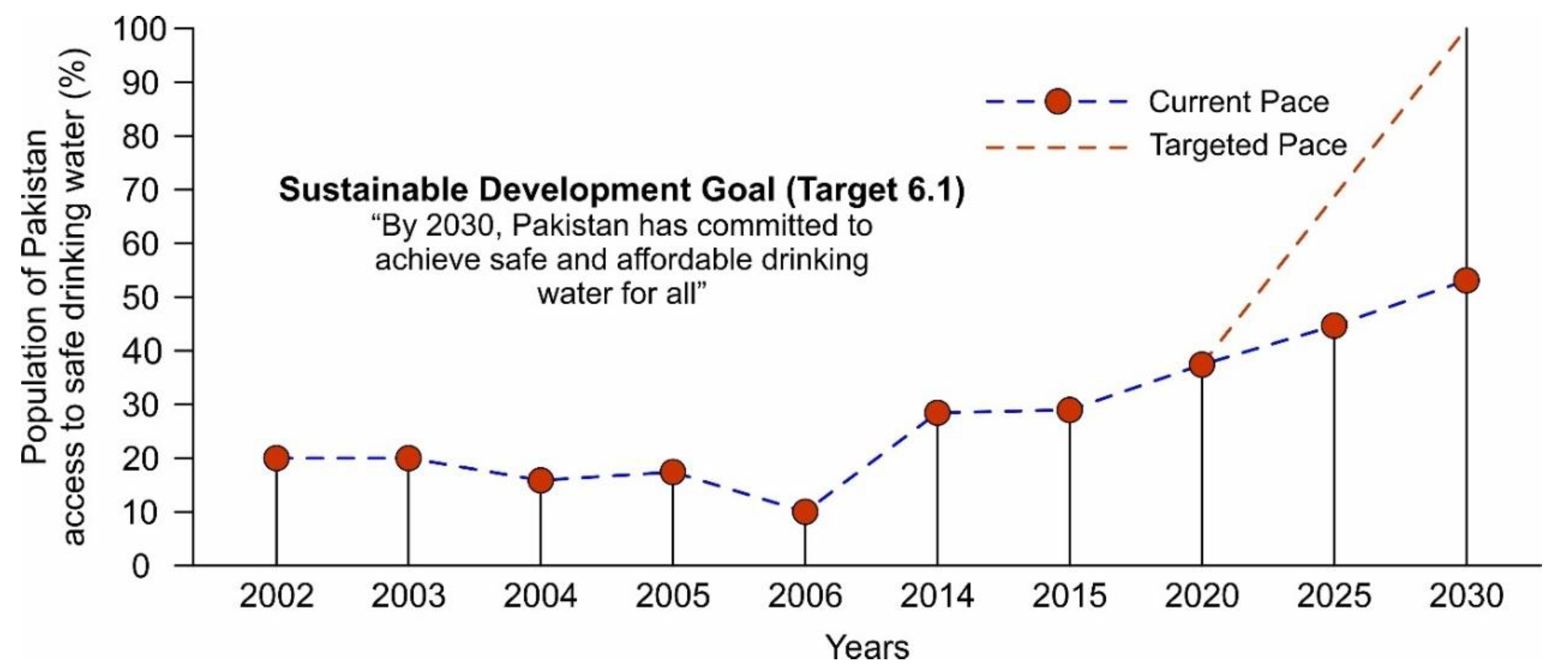

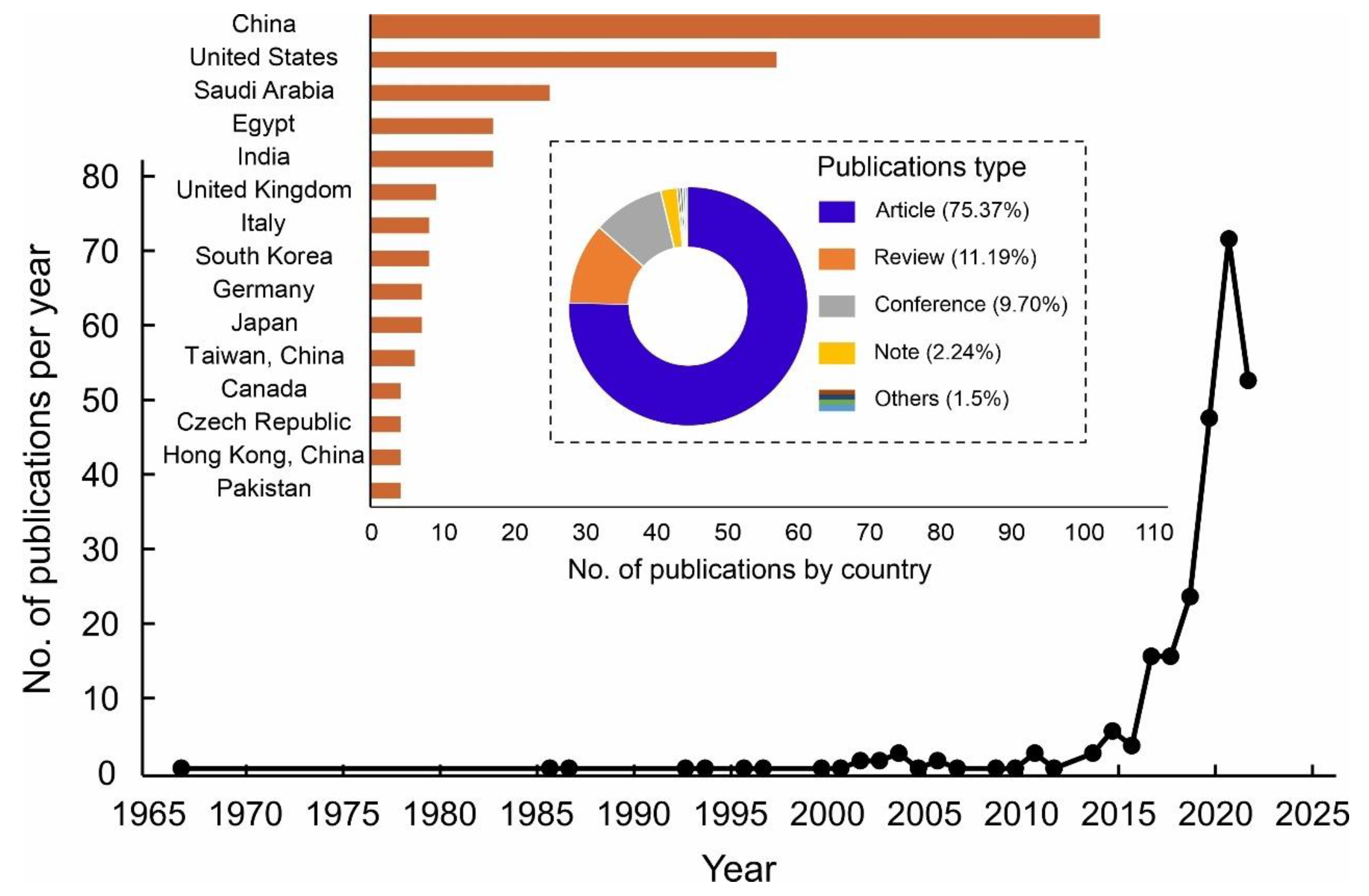
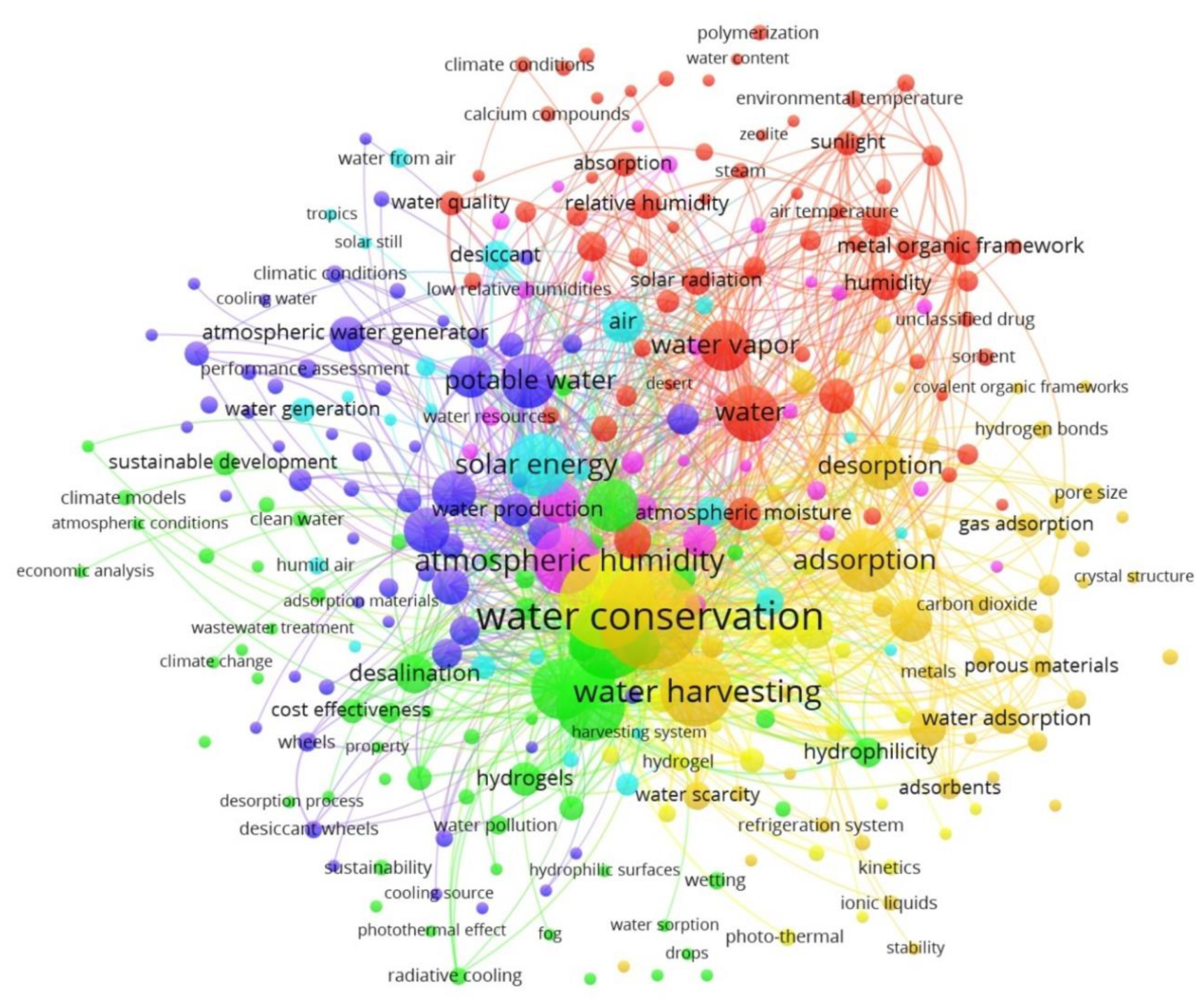
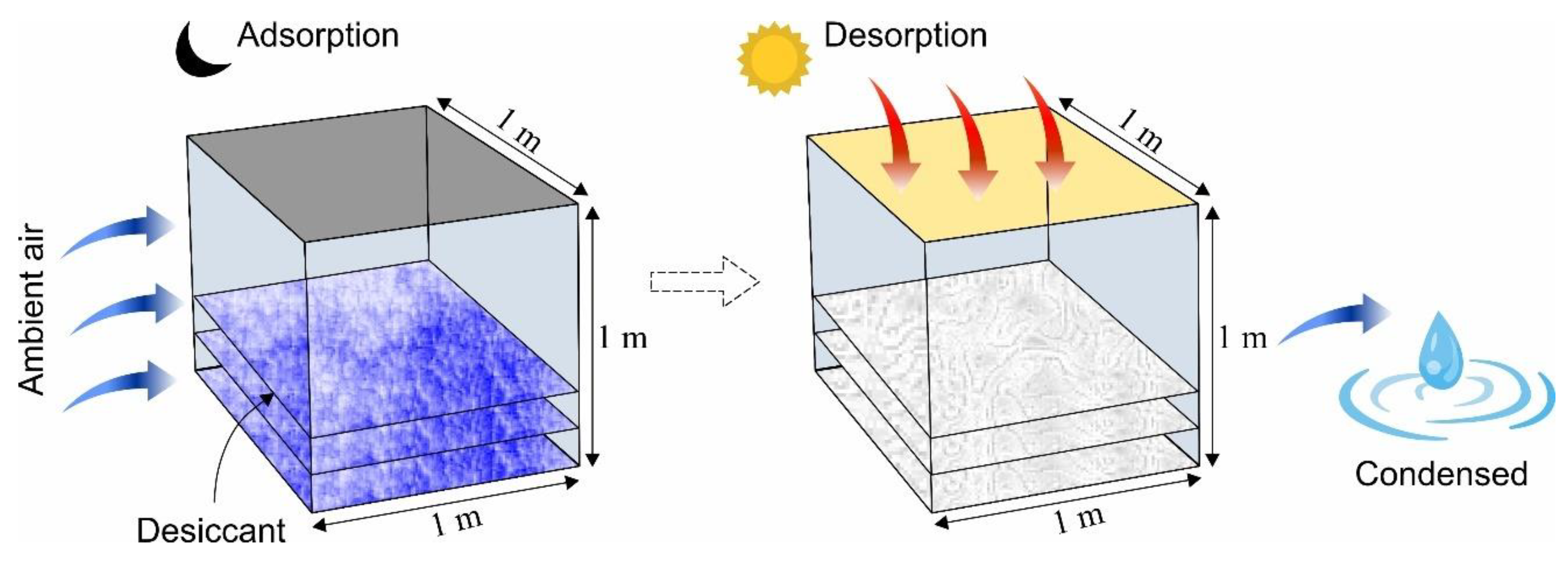


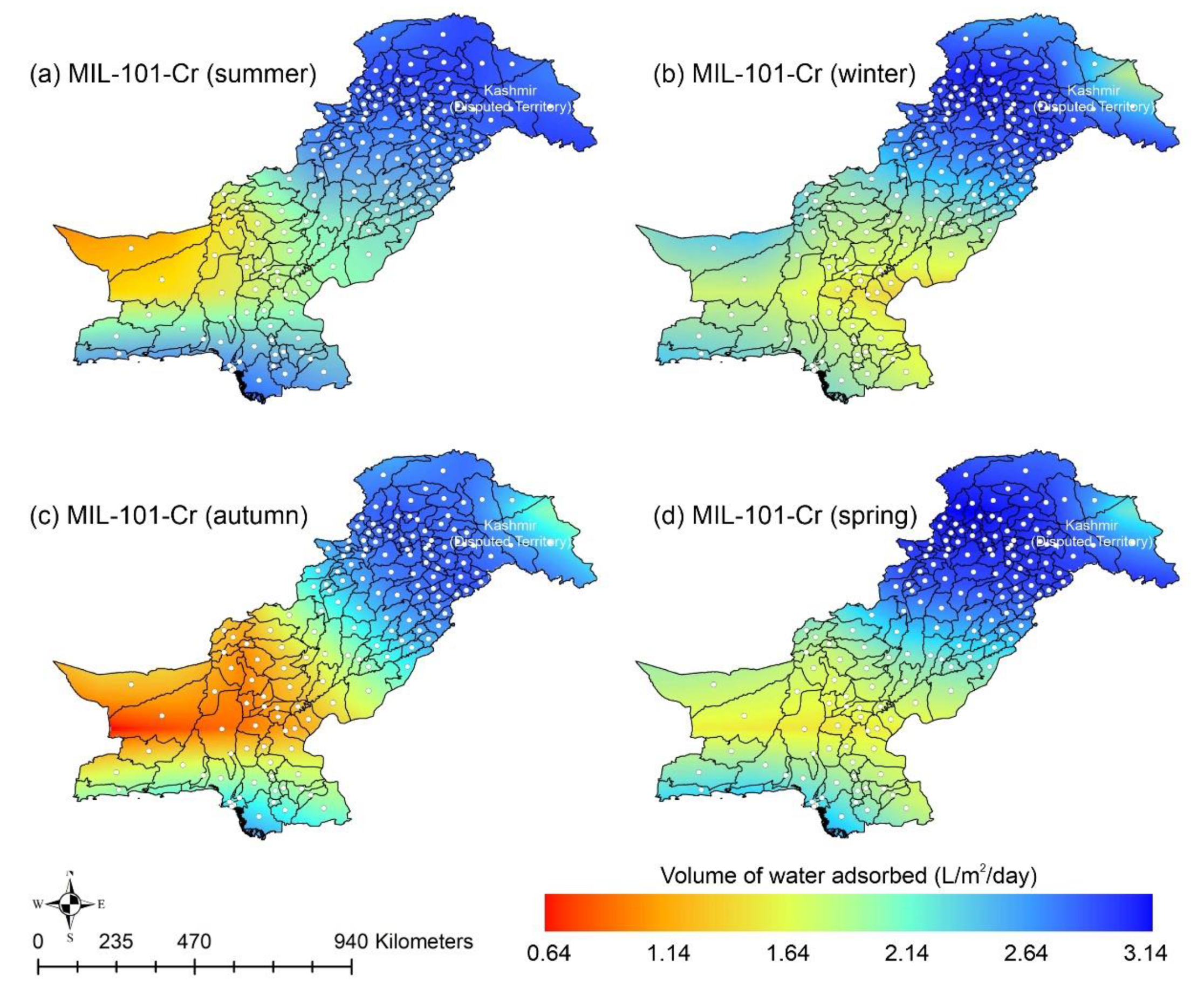
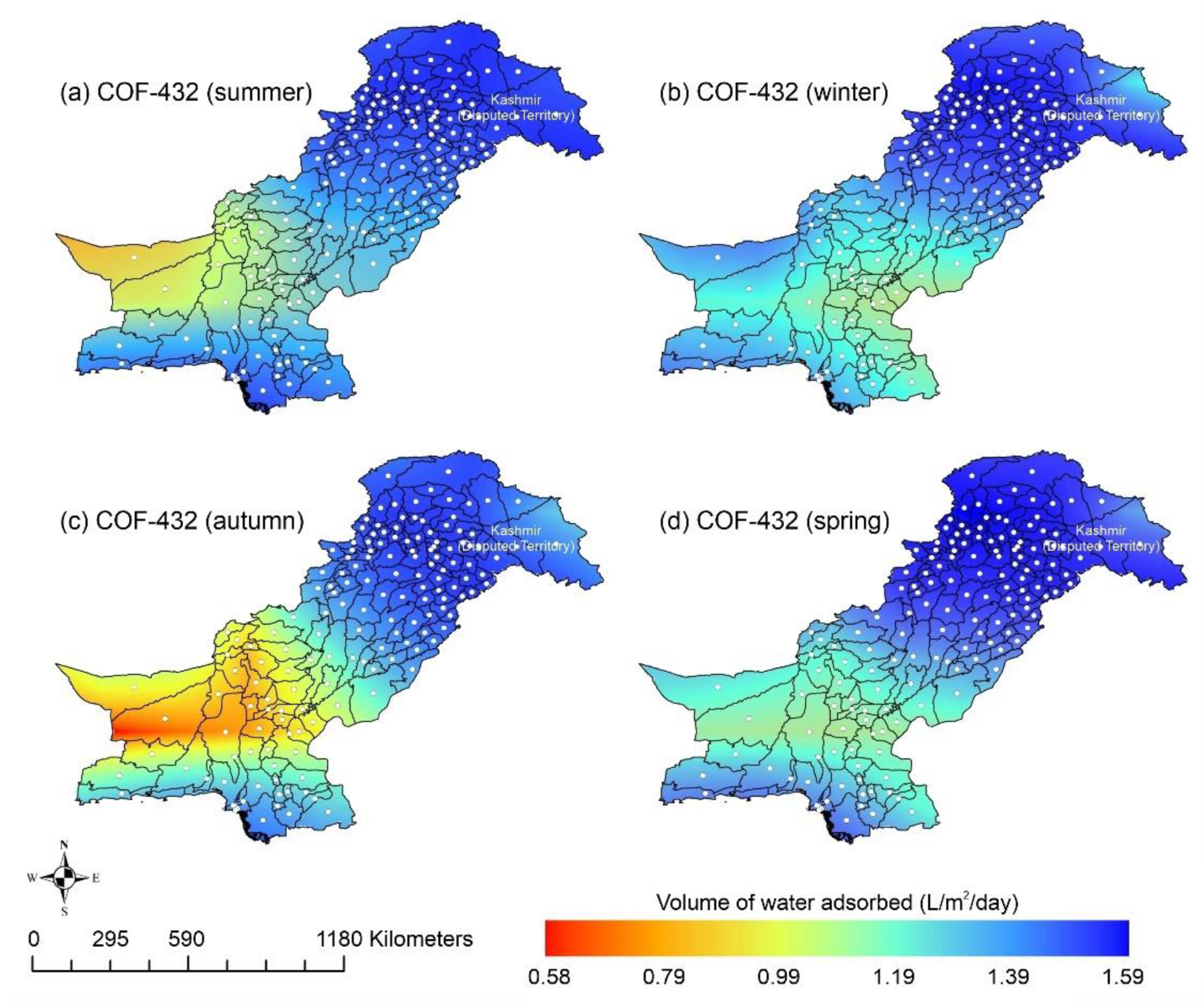
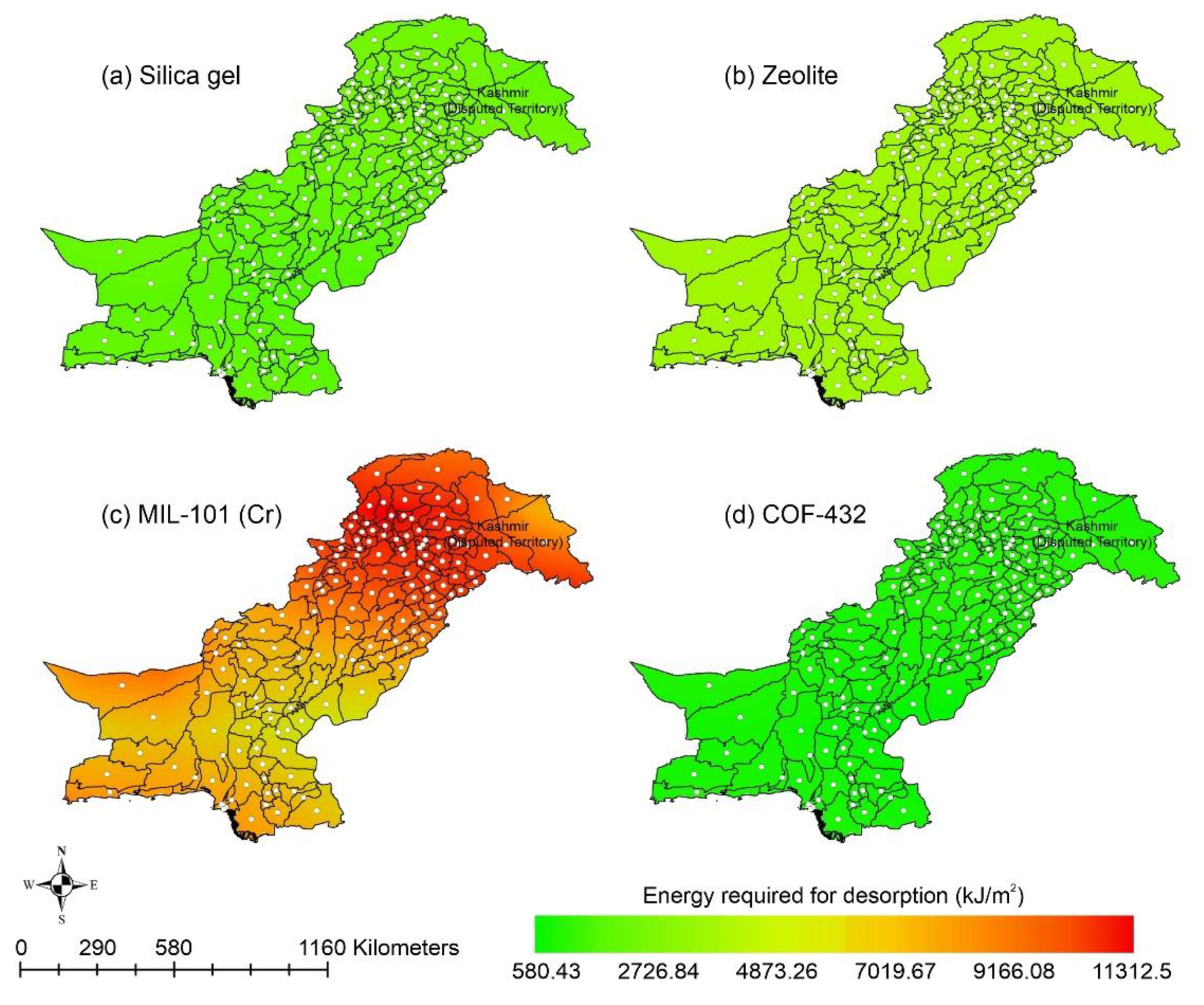

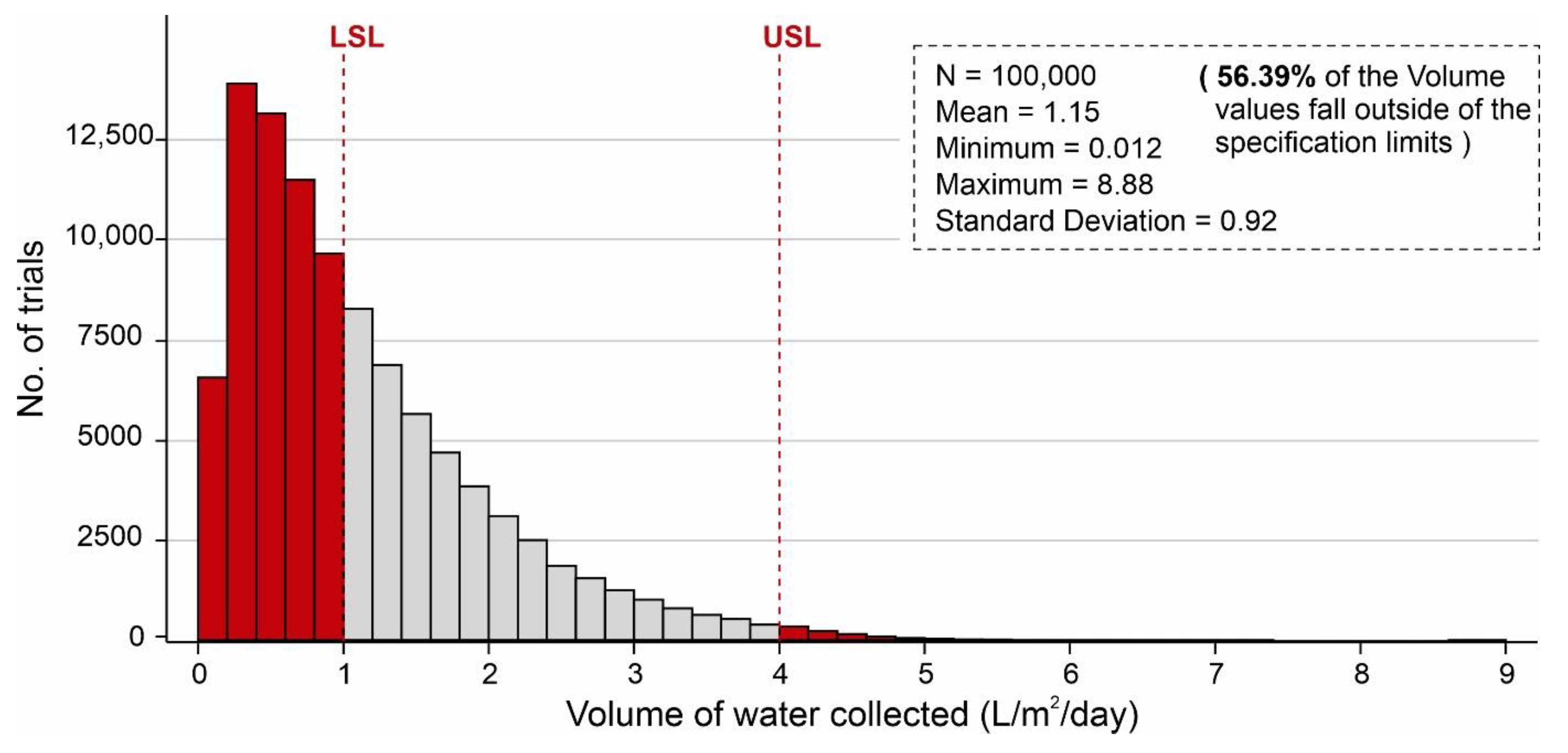
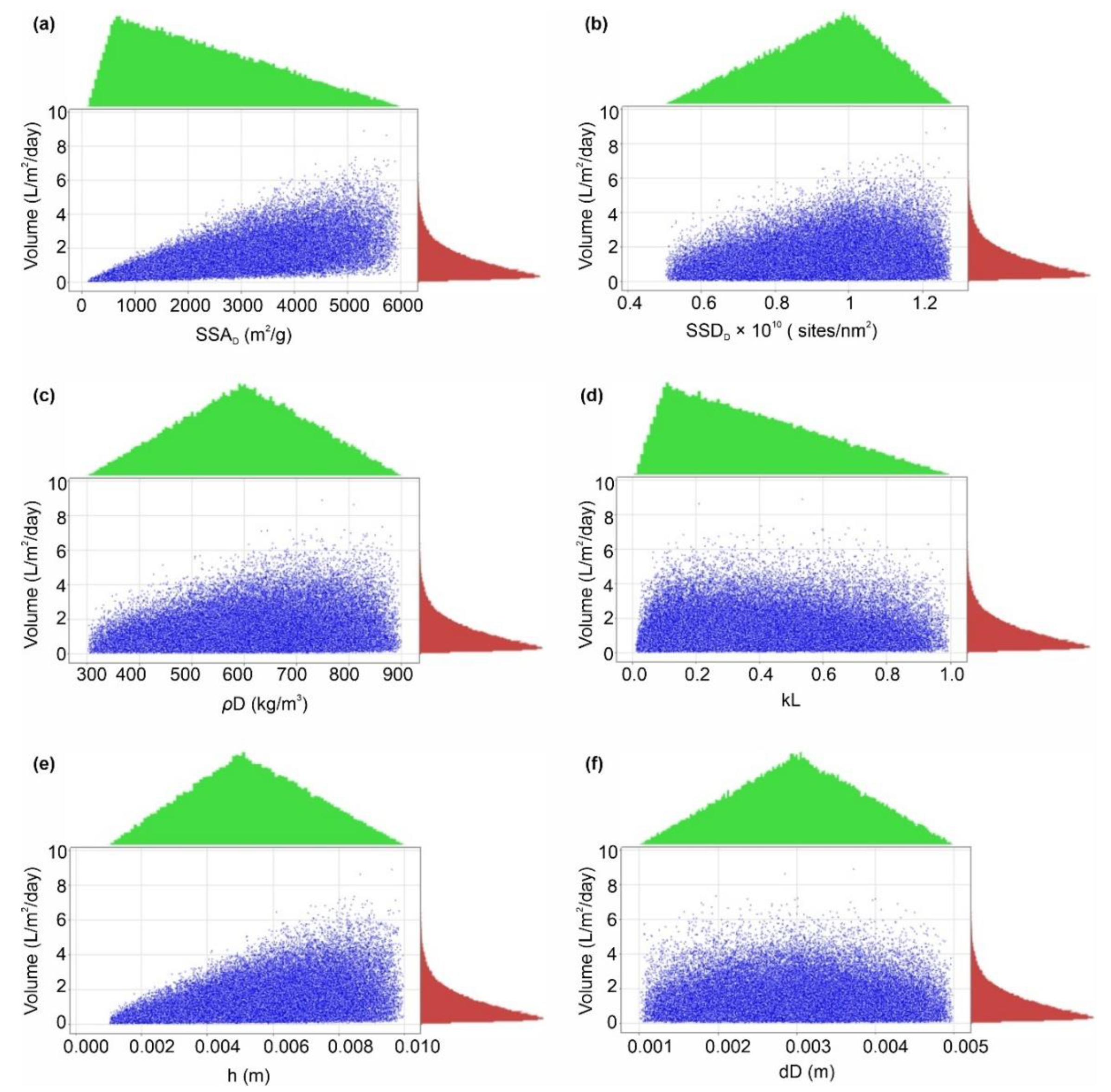

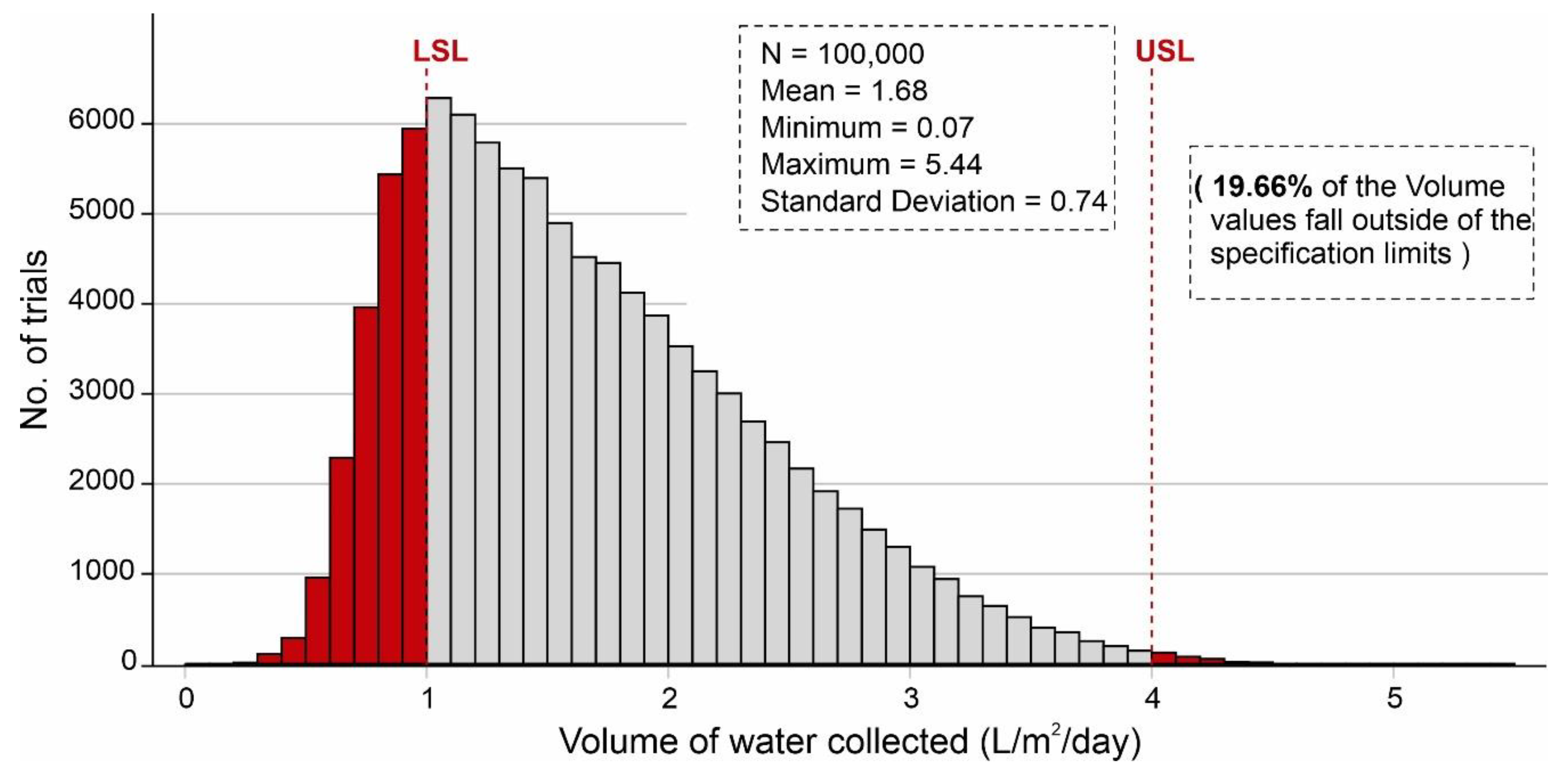

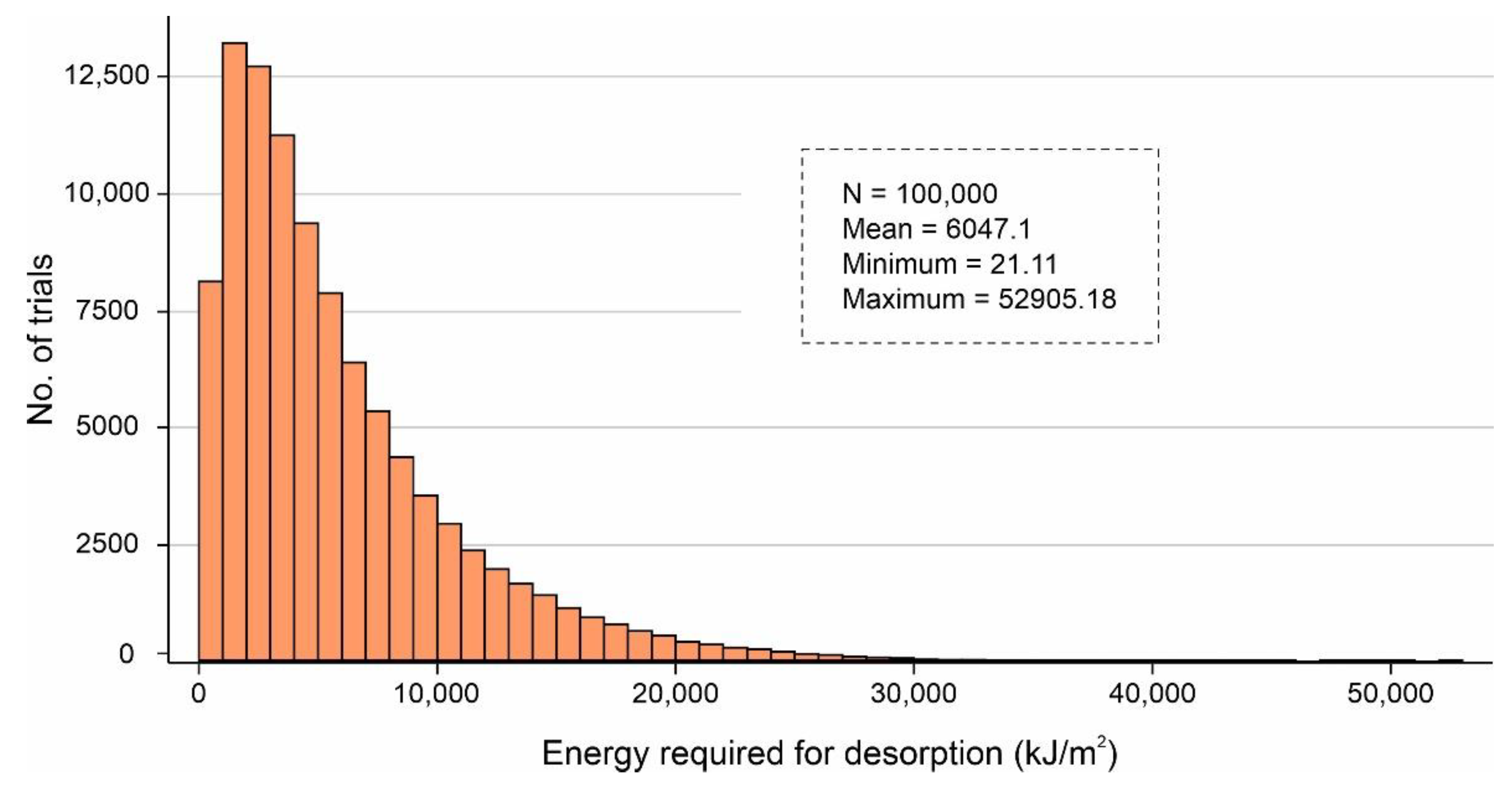
| No. | Citations | Title | Journal | Year | References |
|---|---|---|---|---|---|
| 1 | 902 | Water Harvesting from Air with Metal-Organic Frameworks powered by Natural Sunlight | Science | 2017 | [52] |
| 2 | 324 | Metal–Organic Frameworks for Water Harvesting from Air | Advanced Materials | 2018 | [37] |
| 3 | 304 | Adsorption-based Atmospheric Water Harvesting Device for Arid Climates | Nature communications | 2018 | [53] |
| 4 | 227 | Progress and Expectation of Atmospheric Water Harvesting | Joule | 2018 | [54] |
| 5 | 168 | Super Moisture-Absorbent Gels for All-Weather Atmospheric Water Harvesting | Advanced Materials | 2019 | [55] |
| 6 | 166 | Rapid Cycling and Exceptional Yield in a Metal-Organic Framework Water Harvester | ACS Central Science | 2019 | [56] |
| 7 | 162 | MOF Water Harvesters | Nature Nanotechnology | 2020 | [36] |
| 8 | 151 | The Effects of Surface Wettability on the Fog and Dew Moisture Harvesting Performance on Tubular Surfaces | Scientific Reports | 2016 | [57] |
| 9 | 145 | Tunable Water and CO2 Sorption Properties in Isostructural Azine-based Covalent Organic Frameworks through Polarity Engineering | Chemistry of Materials | 2015 | [58] |
| 10 | 140 | Hybrid Hydrogel with High Water Vapor Harvesting Capacity for Deployable Solar-Driven Atmospheric Water Generator | Environmental Science and Technology | 2018 | [59] |
| 11 | 120 | Harnessing Solar-Driven Photothermal Effect toward the Water–Energy Nexus | Advanced Science | 2019 | [60] |
| 12 | 105 | Solar Energy Triggered Clean Water Harvesting from Humid Air Existing above Sea Surface Enabled by a Hydrogel with Ultrahigh Hygroscopicity | Advanced Materials | 2019 | [61] |
| 13 | 105 | Atmospheric Water Harvesting: A Review of Material and Structural Designs | ACS Materials Letters | 2020 | [62] |
| 14 | 102 | Adsorption-based Atmospheric Water Harvesting: Impact of Material and Component Properties on System-Level Performance | Accounts of Chemical Research | 2019 | [63] |
| 15 | 99 | Harvesting Water from Air: Using Anhydrous Salt with Sunlight | Environmental Science and Technology | 2018 | [64] |
| 16 | 95 | Recent Developments in Solid Desiccant Coated Heat Exchangers—A Review | Applied Energy | 2018 | [65] |
| 17 | 95 | Water Production from Air using Multi-Shelves Solar Glass Pyramid System | Renewable Energy | 2007 | [66] |
| 18 | 87 | Water Harvesting from Air with a Hygroscopic Salt in a Hydrogel–Derived Matrix | Communications Chemistry | 2018 | [38] |
| 19 | 85 | Efficient Solar-Driven Water Harvesting from Arid Air with Metal–Organic Frameworks Modified by Hygroscopic Salt | Angewandte Chemie—International Edition | 2020 | [67] |
| 20 | 84 | Improving Atmospheric Water Production Yield: Enabling Multiple Water Harvesting Cycles with Nano Sorbent | Nano Energy | 2020 | [68] |
| Units | Silica | Zeolite | MIL-101 | COF-432 | References | |
|---|---|---|---|---|---|---|
| Desiccant diameter | (mm) | 4 | 4 | 4 | 4 | Assumption |
| Desiccant bulk density | (kg/m3) | 750 | 650 | 350 | 875 | [69,72,74] |
| Specific surface area | (m2/g) | 830 | 600 | 5900 | 895 | [75,76,77] |
| Specific site density | (sites/nm2) | 12.8 | 12.8 | N/A | N/A | [78] |
| Langmuir constant | 0.05 | 0.8 | N/A | N/A | Calculated | |
| Bed depth | (mm) | 10 | 10 | 10 | 10 | [79] |
| Mass of desiccants in a system | (kg) | 4.8 | 4.16 | 2.24 | 5.728 | Calculated |
| Activation energy | (kJ/mol) | 35 | 70 | 65 | 10 | [75,79,80] |
| Parameters | Units | Distribution | Values in Distribution | References | ||
|---|---|---|---|---|---|---|
| Lower | Mode | Upper | ||||
| SSAD | (m2/g) | Triangular | 100 | 600 | 6000 | [72,86] |
| SSDD | (sites/nm2) | Triangular | 0.5 × 1010 | 1 × 1010 | 1.28 × 1010 | [78] |
| ρD | kg/m3 | Triangular | 300 | 600 | 900 | [38,87] |
| dD | mm | Triangular | 0.001 | 0.003 | 0.005 | [38,87] |
| h | mm | Triangular | 0.001 | 0.005 | 0.01 | [63] |
| kL | Triangular | 0.01 | 0.1 | 1 | Calculated | |
| RH | % | Triangular | 1 | 50 | 100 | Assumption |
| qD | (kg/kg) | Triangular | 0.019 | 0.55 | 2.5 | Calculated |
| m | kg/m2 | Triangular | 0.2 | 1.9 | 6.1 | Calculated |
| Edes | (kJ/mol) | Triangular | 2 | 35 | 80 | [75,80,88] |
| Parameter Optimization | |||||||||
|---|---|---|---|---|---|---|---|---|---|
| Parameters | Distribution | Parameter Optimization (New Values in Distribution) | Search Range | Preceding Values in the Distribution | |||||
| Lower | Mode | Upper | Low | High | Lower | Mode | Upper | ||
| SSAD | Triangular | 400 | 900 | 6300 | 200 | 900 | 100 | 600 | 6000 |
| SSDD | Triangular | 0.5 × 1010 | 1 × 1010 | 1.28 × 1010 | - | - | 0.5 × 1010 | 1 × 1010 | 1.28 × 1010 |
| ρD | Triangular | 427 | 727 | 1027 | 400 | 800 | 300 | 600 | 900 |
| dD | Triangular | 0.00131 | 0.00331 | 0.00531 | 0.002 | 0.004 | 0.001 | 0.003 | 0.005 |
| h | Triangular | 0.003 | 0.008 | 0.012 | 0.001 | 0.008 | 0.001 | 0.005 | 0.01 |
| kL | Triangular | 0.01 | 0.1 | 1 | - | - | 0.01 | 0.1 | 1 |
| RH | Triangular | 1 | 50 | 100 | - | - | 1 | 50 | 100 |
| Sensitivity Analysis | |||||||||
| Parameters | Distribution | Sensitivity Analysis (New Values in Distribution) | % Change in Standard Deviation | Preceding Values in the Distribution | |||||
| Lower | Mode | Upper | Lower | Mode | Upper | ||||
| SSAD | Triangular | 650 | 900 | 3600 | −50% | 400 | 900 | 6300 | |
| SSDD | Triangular | 0.75 × 1010 | 1 × 1010 | 1.14 × 1010 | −50% | 0.5 × 1010 | 1 × 1010 | 1.28 × 1010 | |
| ρD | Triangular | 577 | 727 | 877 | −50% | 427 | 727 | 1027 | |
| dD | Triangular | 0.00131 | 0.00331 | 0.00531 | - | 0.00131 | 0.00331 | 0.00531 | |
| h | Triangular | 0.006 | 0.007 | 0.010 | −50% | 0.003 | 0.008 | 0.012 | |
| kL | Triangular | 0.01 | 0.1 | 1 | - | 0.01 | 0.1 | 1 | |
| RH | Triangular | 1 | 50 | 100 | - | 1 | 50 | 100 | |
Publisher’s Note: MDPI stays neutral with regard to jurisdictional claims in published maps and institutional affiliations. |
© 2022 by the authors. Licensee MDPI, Basel, Switzerland. This article is an open access article distributed under the terms and conditions of the Creative Commons Attribution (CC BY) license (https://creativecommons.org/licenses/by/4.0/).
Share and Cite
Bilal, M.; Sultan, M.; Majeed, F.; Farooq, M.; Sajjad, U.; Ibrahim, S.M.; Khan, M.U.; Azizi, S.; Javaid, M.Y.; Ahmad, R. Investigating Adsorption-Based Atmospheric Water Harvesting Potential for Pakistan. Sustainability 2022, 14, 12582. https://doi.org/10.3390/su141912582
Bilal M, Sultan M, Majeed F, Farooq M, Sajjad U, Ibrahim SM, Khan MU, Azizi S, Javaid MY, Ahmad R. Investigating Adsorption-Based Atmospheric Water Harvesting Potential for Pakistan. Sustainability. 2022; 14(19):12582. https://doi.org/10.3390/su141912582
Chicago/Turabian StyleBilal, Muhammad, Muhammad Sultan, Faizan Majeed, Muhammad Farooq, Uzair Sajjad, Sobhy M. Ibrahim, Muhammad Usman Khan, Shohreh Azizi, Muhammad Yasar Javaid, and Riaz Ahmad. 2022. "Investigating Adsorption-Based Atmospheric Water Harvesting Potential for Pakistan" Sustainability 14, no. 19: 12582. https://doi.org/10.3390/su141912582
APA StyleBilal, M., Sultan, M., Majeed, F., Farooq, M., Sajjad, U., Ibrahim, S. M., Khan, M. U., Azizi, S., Javaid, M. Y., & Ahmad, R. (2022). Investigating Adsorption-Based Atmospheric Water Harvesting Potential for Pakistan. Sustainability, 14(19), 12582. https://doi.org/10.3390/su141912582










